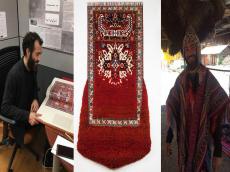|
|
TODAY.AZ / Arts & Entertainment
Exhibition of national artist to open in Washington
04 October 2018 [14:32] - TODAY.AZ

By Azernews
By Laman Ismayilova
A personal exhibition by Faig Ahmed entitled "Nonvisual Language" will open at the Museum of Textiles at George Washington University on October 6.
The exhibition will feature new works on which the artist worked after returning from Peru.
The preparation for the exhibition began about a year ago. As part of his research activities, Faig Ahmed went to Peru for the first time. After examining the collections of Peruvian textiles, as well as the texts, objects and embroideries of the Shipibo-Conibo tribe at the Washington Textile Museum, the artist spent a month in a remote village hidden in the thick of the Amazonian jungle in the territory of modern Peru.
One of the main goals of the trip was to get acquainted with the rich and ancient culture of the Shipibo-Conibo tribe. Faig has long been fascinated and interested patterns on fabrics and ceramics, which are fundamentally different from the patterns and familiar patterns that we see everywhere. The peculiarity of these patterns is that they are applied by shamans, who traditionally have a strong connection with nature, which the city dweller has long since and, unfortunately, lost.
This connection is realized through communication with plants and with the earth. As the Shamans themselves say, plants have consciousness, and it is much more ancient than human consciousness. And that is why people should actively learn from nature. Patterns created in the Shipibo tribe are not separated from the concept of sound or vibration.
There is even a term denoting sound and pattern as a single substance. Thus, with the creation of a new language, Shipibo tribe expanded the limits of textiles and its connection with the subconscious.
In the course of his research, Faig also relied on the work of the Azerbaijani scientist and professor Khudu Mammadov, who studied the connection of music, in particular, mugham and patterns of carpets.
Through his works, the artist shows that all techniques of ornament formation on textiles around the world are somehow similar, which is why patterns created on traditional Azerbaijani carpets and Peruvian textiles can be reduced to a single base.








URL: http://www.today.az/news/entertainment/174524.html
 Print version
Print version
Connect with us. Get latest news and updates.
See Also
- 14 July 2025 [14:49]
Experience Movie Night magic at Seaside Boulevard - 14 July 2025 [14:16]
Baku, Tashkent discuss joint cultural partnership - 13 July 2025 [16:30]
Young azerbaijani artists exhibit at Tbilisi State Academy of Arts - 13 July 2025 [11:05]
Today is birthday of renowned cinematographer Rasim Ismayilov - 13 July 2025 [10:00]
99 years on: enduring legacy of Vidadi Narimanbayov - 11 July 2025 [11:24]
People's Artist Gabil Guliyev to hold seminar on acting in Lankaran - 10 July 2025 [15:28]
National Library celebrates Seyid Azim Shirvani's legacy of enlightenment and poetry - 10 July 2025 [14:47]
Cinema Agency outlines film projects competition rules - 10 July 2025 [12:43]
Shusha State Musical Drama Theater premieres new play - 09 July 2025 [15:23]
Baku Museum Center displays art works by young artists
Most Popular
 Israeli, Palestinian foreign ministers to attend rare joint meeting in Brussels
Israeli, Palestinian foreign ministers to attend rare joint meeting in Brussels
 Turkiye closely follows Azerbaijan–Armenia peace talks in Abu Dhabi
Turkiye closely follows Azerbaijan–Armenia peace talks in Abu Dhabi
 Azerbaijan’s Deputy Foreign Minister highlights country’s strategic role at Dubrovnik Forum
Azerbaijan’s Deputy Foreign Minister highlights country’s strategic role at Dubrovnik Forum
 Rebuilding Peace: Return of liberated lands marks new national era
Rebuilding Peace: Return of liberated lands marks new national era
 It will be 40 degrees Celsius in Baku and rain expected in mountainous areas
It will be 40 degrees Celsius in Baku and rain expected in mountainous areas
 Mild winds and warm waters expected at Absheron beaches on July 14
Mild winds and warm waters expected at Absheron beaches on July 14
 Global pressure mounts as France redefines New Caledonia’s status
Global pressure mounts as France redefines New Caledonia’s status
